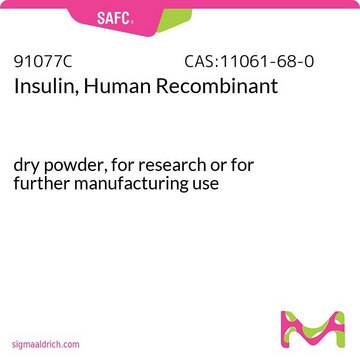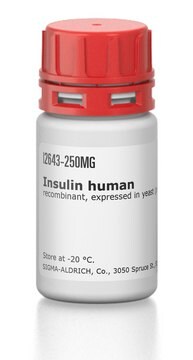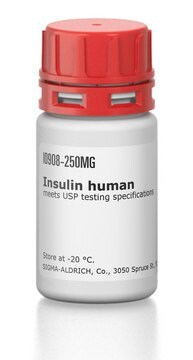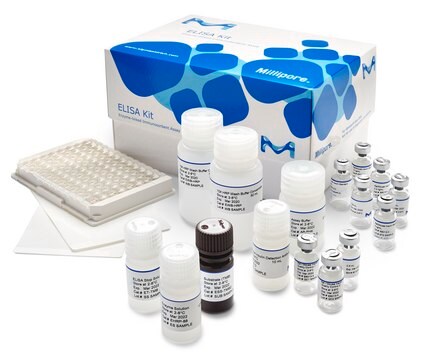11376497001
Roche
Insulina
recombinant (yeast)
Sinonimo/i:
Insulin human
Autenticatiper visualizzare i prezzi riservati alla tua organizzazione & contrattuali
About This Item
Formula empirica (notazione di Hill):
C257H383N65O77S6
Numero CAS:
Peso molecolare:
5807.57
Numero MDL:
Codice UNSPSC:
12352200
Prodotti consigliati
Livello qualitativo
Sterilità
non-sterile; 0.2 μm filtered
Saggio
>98% (SDS-PAGE)
Stato
lyophilized (clear, colorless solution after reconstitution)
PM
5,700 Da
Confezionamento
pkg of 100 mg
Produttore/marchio commerciale
Roche
tecniche
cell culture | mammalian: suitable
Impurezze
<0.1 EU/μg endotoxin (LAL test)
Solubilità
water: soluble
N° accesso UniProt
Temperatura di conservazione
2-8°C
InChI
PBGKTOXHQIOBKM-FHFVDXKLSA-N
Informazioni sul gene
human ... INS(3630)
Cerchi prodotti simili? Visita Guida al confronto tra prodotti
Descrizione generale
At least the same specific activity (EC<sub>50</sub>) compared to the indicated standard is guaranteed.
Recombinant Insulin, human, is produced in yeast and purified by standard chromatographic techniques. Insulin regulates blood glucose. In muscles and adipocytes it stimulates glucose intake and metabolism. It also controls the expression and various enzymes.
Specificità
Insulin, human, is active on most mammalian cells.
Applicazioni
Insulin shows a broad range of activities on a variety of somatic cells. Recombinant human insulin can be used to stimulate growth and proliferation of cultured cells and to investigate insulin activity on sensitive cells used in research studies. It is also a component of serum-free media formulations for most primary cells and cell lines.
Azioni biochim/fisiol
Ormone polipeptidico a doppia catena prodotto dalle cellule β delle isole pancreatiche. Il suo peso molecolare è ~ 5800 Da. Le catene α e β sono unite da due ponti disolfuro interconnessi. La catena α contiene un ponte disolfuro interno. L′insulina regola l′assorbimento, l′utilizzazione e lo stoccaggio di glucosio, amminoacidi e acidi grassi e inibisce la rottura di glicogeno, proteine e grassi.
Regola l′assorbimento, l′utilizzazione e lo stoccaggio di glucosio, amminoacidi e acidi grassi e inibisce la rottura di glicogeno, proteine e grassi.
Altre note
InChI: 1S/C257H383N65O77S6/c1-29-131(23)205(313-193(339)104-259)252(393)317-204(130(21)22)248(389)288-159(75-82-200(349)350)217(358)282-156(71-78-189(263)335)221(362)308-183-116-403-404-117-184-243(384)305-178(111-324)240(381)294-162(88-123(7)8)225(366)295-168(95-140-53-61-146(329)62-54-140)228(369)283-154(69-76-187(261)333)218(359)290-161(87-122(5)6)223(364)285-158(74-81-199(347)348)220(361)302-174(101-190(264)336)235(376)298-170(97-142-57-65-148(331)66-58-142)231(372)309-182(242(383)304-176(255(396)397)103-192(266)338)115-402-401-114-181(214(355)273-107-194(340)278-153(72-79-197(343)344)216(357)281-151(51-42-84-271-257(267)268)212(353)272-108-195(341)279-166(93-138-46-36-32-37-47-138)227(368)297-167(94-139-48-38-33-39-49-139)230(371)299-171(98-143-59-67-149(332)68-60-143)238(379)320-208(135(27)327)254(395)322-85-43-52-186(322)246(387)286-152(50-40-41-83-258)222(363)321-209(136(28)328)256(398)399)311-250(391)203(129(19)20)316-236(377)164(90-125(11)12)292-229(370)169(96-141-55-63-147(330)64-56-141)296-224(365)160(86-121(3)4)289-210(351)133(25)277-215(356)157(73-80-198(345)346)287-247(388)202(128(17)18)315-237(378)165(91-126(13)14)293-233(374)173(100-145-106-270-120-276-145)301-239(380)177(110-323)280-196(342)109-274-213(354)180(113-400-405-118-185(310-244(183)385)245(386)319-207(134(26)326)253(394)306-179(112-325)241(382)318-206(132(24)30-2)251(392)312-184)307-226(367)163(89-124(9)10)291-232(373)172(99-144-105-269-119-275-144)300-219(360)155(70-77-188(262)334)284-234(375)175(102-191(265)337)303-249(390)201(127(15)16)314-211(352)150(260)92-137-44-34-31-35-45-137/h31-39,44-49,53-68,105-106,119-136,150-186,201-209,323-332H,29-30,40-43,50-52,69-104,107-118,258-260H2,1-28H3,(H2,261,333)(H2,262,334)(H2,263,335)(H2,264,336)(H2,265,337)(H2,266,338)(H,269,275)(H,270,276)(H,272,353)(H,273,355)(H,274,354)(H,277,356)(H,278,340)(H,279,341)(H,280,342)(H,281,357)(H,282,358)(H,283,369)(H,284,375)(H,285,364)(H,286,387)(H,287,388)(H,288,389)(H,289,351)(H,290,359)(H,291,373)(H,292,370)(H,293,374)(H,294,381)(H,295,366)(H,296,365)(H,297,368)(H,298,376)(H,299,371)(H,300,360)(H,301,380)(H,302,361)(H,303,390)(H,304,383)(H,305,384)(H,306,394)(H,307,367)(H,308,362)(H,309,372)(H,310,385)(H,311,391)(H,312,392)(H,313,339)(H,314,352)(H,315,378)(H,316,377)(H,317,393)(H,318,382)(H,319,386)(H,320,379)(H,321,363)(H,343,344)(H,345,346)(H,347,348)(H,349,350)(H,396,397)(H,398,399)(H4,267,268,271)/t131-,132-,133-,134+,135+,136+,150-,151-,152-,153-,154-,155-,156-,157-,158-,159-,160-,161-,162-,163-,164-,165-,166-,167-,168-,169-,170-,171-,172-,173-,174-,175-,176-,177-,178-,179-,180-,181-,182-,183-,184-,185-,186-,201-,202-,203-,204-,205-,206-,207-,208-,209-/m0/s1
For life science research only. Not for use in diagnostic procedures.
Qualità
Endotoxin level: <0.1EU/μg (LAL-test)
Note: 1 EU corresponds to 0.1ng
Note: 1 EU corresponds to 0.1ng
Sequenza
A-chain: 21 AS, B-chain: 30 AS, connected by two disulfide bridges
Two polypeptide chains (A-chain: 21 amino acids, B-chain: 30 amino acids, connected by two disulfide bridges) identical to natural, human insulin.
Definizione di unità
EC50 definition: The concentration of human insulin that is required to support half-maximal stimulation of cell proliferation (MTT cleavage) with 3T3 (A31) cells.
Stato fisico
Lyophilizate from a hydrochloric acid solution (pH 2.3) (crystalline insulin)
Nota sulla preparazione
Working concentration: 1-10 μg/ml
Recommended concentration for serum-free cell culture is 1-10 μg/ml.
The concentration of insulin required for stimulation of cell growth in almost all cases is extraordinarily high compared with the physiological concentration. Insulin may be mimicking insulin-like growth factors (IGFs, somatomedins) for some cell lines, and high insulin concentrations may be necessary to occupy receptors which have a high affinity for IGFs and a lower affinity for insulin.
Working solution: Dissolve Insulin, human, recombinant (100 mg or 500 mg), in sterile, double-dist. water (final concentration: 10 mg/ml).
Storage conditions (working solution): -15 to -25 °C
The reconstituted, undiluted solution is stable at -15 to -25 °C.
Note: Avoid repeated freezing and thawing.
Recommended concentration for serum-free cell culture is 1-10 μg/ml.
The concentration of insulin required for stimulation of cell growth in almost all cases is extraordinarily high compared with the physiological concentration. Insulin may be mimicking insulin-like growth factors (IGFs, somatomedins) for some cell lines, and high insulin concentrations may be necessary to occupy receptors which have a high affinity for IGFs and a lower affinity for insulin.
Working solution: Dissolve Insulin, human, recombinant (100 mg or 500 mg), in sterile, double-dist. water (final concentration: 10 mg/ml).
Storage conditions (working solution): -15 to -25 °C
The reconstituted, undiluted solution is stable at -15 to -25 °C.
Note: Avoid repeated freezing and thawing.
Ricostituzione
Reconstitute in sterile double-distilled water (final concentration 10 mg/ml), further dilution with PBS (phosphate buffered saline) or medium containing 1 mg/ml (0.1%) BSA (bovine serum albumin) [or HSA (human serum albumin)], or 1 to 10% serum.
Comunemente ordinati con questo prodotto
N° Catalogo
Descrizione
Determinazione del prezzo
Classe di pericolosità dell'acqua (WGK)
nwg
Punto d’infiammabilità (°F)
Not applicable
Punto d’infiammabilità (°C)
Not applicable
Scegli una delle versioni più recenti:
Possiedi già questo prodotto?
I documenti relativi ai prodotti acquistati recentemente sono disponibili nell’Archivio dei documenti.
I clienti hanno visto anche
E A Gorbunov et al.
Nutrition & diabetes, 5, e169-e169 (2015-07-07)
It has been previously shown that Subetta (a drug containing released-active forms of antibodies to the insulin receptor β-subunit and antibodies to endothelial nitric oxide synthase) stimulated insulin-induced adiponectin production by mature human adipocytes in the absence of insulin. Therefore
Linda Jacobsen et al.
BioTechniques, 47(1), 617-624 (2009-07-15)
Transfection is used to introduce a gene of interest into a cell. To interpret the downstream results, understanding which effects are the true biological responses to the gene and which, if any, are off-target effects can be difficult. In order
Hayma Hammoud et al.
Acta physiologica (Oxford, England), 232(2), e13623-e13623 (2021-02-10)
We examined if tonic γ-aminobutyric acid (GABA)-activated currents in primary hippocampal neurons were modulated by insulin in wild-type and tg-APPSwe mice, an Alzheimer's disease (AD) model. GABA-activated currents were recorded in dentate gyrus (DG) granule cells and CA3 pyramidal neurons
The insulin signaling system.
M F White et al.
The Journal of biological chemistry, 269(1), 1-4 (1994-01-07)
Rafael Contreras-Montoya et al.
ACS applied materials & interfaces, 13(10), 11672-11682 (2021-03-05)
Protein therapeutics have a major role in medicine in that they are used to treat diverse pathologies. Their three-dimensional structures not only offer higher specificity and lower toxicity than small organic compounds but also make them less stable, limiting their
Il team dei nostri ricercatori vanta grande esperienza in tutte le aree della ricerca quali Life Science, scienza dei materiali, sintesi chimica, cromatografia, discipline analitiche, ecc..
Contatta l'Assistenza Tecnica.












